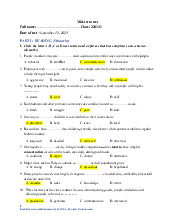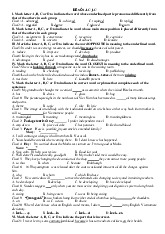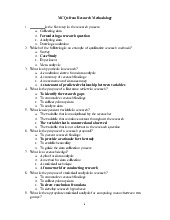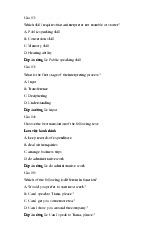

















Preview text:
UNIT 12: BUSINESS PLANNING
Câu 1: (2 điểm): Choose the best word to fill in each gap.
1. ………………….. enables management to think through the business in a logical and
structured way and to set out the stages in the achievement of the business objectives. A. International marketing B. Business planning C. Organizational Behavior D. Leadership and Management
2.……………………. enables management to plot progress against the plan. A. Business planning B. International marketing C. Organizational Behavior D. Leadership and Management
3 .…………………….. ensures that both of the resources needed to carry out the strategy
and the time when they are required are identified. A. Organizational Behavior B. International marketing C. Business planning D. Leadership and Management
4. Business planning is an important document for discussion with prospective
…………………….. and lenders of finance. A. leaders B. managers C. inventors D. investors
5. A business plan has to be particular to the organization in question, its situation and
time. However, a business plan is not just a…………………, to be produced and filed.
Business planning is a continuous process. A. document B. papers C. text file D. book
6. The business plan has to be a living document, constantly in use to monitor,
………………and guide the progress of a business. A. limit B. control C. command D. master
7. The previous review of the business plan and its …………………..will help highlight
which areas of the business have proved difficult to forecast historically. A. income B. result C. outcome D. outgone
8. A business plan must have a purpose, set out the key business
……………………….on which their plans will be based (such as inflation, exchange
rates, market growth, competitive pressures and so on) and take a critical look at their business. A. presumptions B. suppositions C. claims D. assumptions
9. The strategies adopted by a business will be largely based on the outcome of the SWOT…………………….. A. analysis B. synthesis C. strategy D. plan
10. The one-year plan, or budget, will be prepared in such a way that progress can be
regularly monitored by checking the ……………………..between the actual
performance and the budget, which will be phased to take account of seasonal variations. A. invariance B. variance C. differentiation D. division
11. The budget will show financial ……………………..and also non-financial items
such as personnel numbers, output, order book, etc. Budgets can be produced for units,
departments and products as well as for the total organization. A. numbers B. digits C. figures D. calculators
12. The financial analysis includes the company’s projected sales,………………………
and loss statement, balance sheet, cash flow statement, and potentially a few other tables depending on its intended use. A. gain B. benefit C. loss D. profit
13. The most standard business plan covers topics including the company overview, the
products or service you are selling, the target market and strategy of your company, your
……………milestones and goals, management team, and financial forecasting and analysis. A. implementation B. implantation C. effectuation D. execution
14. The cash flow ………………………..is usually considered to be the most important
part of your financial planning and is a no-brainer for inclusion in the plan. A. command B. statement C. instruction D. situation
15. Profitable or not, a business’s plan must prove that it has enough
………………………..to remain operational. A. payment B. credit C. cash D. money
16. A standard business plan will start with an executive summary describing the key points
of your plan, and end with appendices showing monthly …………………………. for the first year. A. ideas B. executions C. expulsions D. projections
17. A startup plan is a very simple business plan that typically includes the following
sections: an executive summary, a company overview, a mission statement, and a market
………………………………………. A. analysis B. plan C. overview D. implementation
18. Even if you do not have the exact numbers for a business plan yet, it’s always a smart
idea to include a ……………………………..analysis of costs, pricing, and probable expenses. A. first B. preliminary C. overture D. prelude
19. If you do not have a business plan, you can use a kind of no-frills plan to
…………………… your options with potential partners and associations. A. prove B. implement C. discuss D. analyze
20. The kind of no-frills plan is good for deciding whether or not to proceed with an idea,
to help gauge whether this is a business ………………..pursuing. A. worthless B. cost C. valuable D. worth
Câu 2 (2 điểm): Circle the correct form of the word
1. Since the purpose of an internal plan is specific to the people directly
……………………… with the company, it will most likely be shorter and more concise
than a fully detailed standard plan that you’d take to the bank. A. involved B. involve C. involving D. involvedly
2. Internal plans are not intended for banks, outside ………………………. or other third parties. A. investing B. investors C. investment D. invest
3. An operation plan includes specific ………………………. milestones, project
deadlines, and responsibilities of team members and managers. A. implement B. implementing C. implementation D. implemented
4. An operation plan is the plan …………………. for staying on track to meet your goals
as a business. Your operation plan covers the inner workings of your business. A. using B. use C. useful D. used
5. ………………………. for your goals as a business allows your company to assign
priorities, focus on results and track your progress. Your operation plan covers the inner workings of your business. A. Planning B. Plannedly C. Planned D. Plan
6. Your operation plan covers the inner workings of your business. Of course, cash flow
figures ……………………………. there as well. A. prominent B. prominently C. prominence D. prominency
7. Your milestones will need to have sufficient funding for their………………………..,and
you’ll need to track your progress so you know how much you’re spending. A. implement B. implementing C. implementation D. implemented
8. A ..………………………. or expansion plan focuses on a specific area of a business, or a subset of the business. A. growing B. grow C. grown D. growth
9. An expansion plan requiring new outside investment would include full company
……………………………. and background on the management team, just the same as a
standard plan for investors would. A. descriptions B. descriptive C. describer D. describing
10. Loan ……………………… would require full company descriptions and background
on the management team much detail as well. A. appliers B. applications C. applicant D. apply
Câu 3 (1 điểm): Choose the best term to match the given definition
1. This is a sum of money allocated for a particular purpose or an estimate of costs,
revenues, and resources over a specified period, reflecting a reading of future financial conditions and goals. A. Budget B. Fund C. Strategy D. Cash
2. It is an elaborate and systematic plan of action or a method or plan chosen to bring
about a desired future, such as achievement of a goal or solution to a problem. A. Analysis B. Strategy C. Program D. Planning
4. An estimate of an expenditure made before the appropriation. A. Forecast B. Strategy C. Forecast out - turn D. Figure
5. This is an estimate of all cash receipts and all cash expenditures that are expected to occur
during a certain time period. Estimates can be made monthly, bimonthly, or quarterly, and
can include nonfarm income and expenditures as well as farm items. It looks only at money
movement, though, not at net income or profitability. A. Budget B. Plan C. Figure D. Cash flow budget
6. This is the aggregation of all lower-level budgets produced by a company's various
functional areas, and also includes budgeted financial statements, a cash forecast, and a financing plan. A. Master budget B. Cash flow budget C. Budget D. Forecast out-turn
7. This is the excess of cash revenues over cash outlays in a given period of time (not
including non-cash expenses). Or anther definition is incomings and outgoings of cash,
representing the operating activities of an organization. A. Cash flow budget B. Cash flow C. Cash D. Cash flow statement
8. It is a process of evaluating how we invest in capital assets or another way to say about it
is the planning process used to determine whether an organization's long term investments
such as new machinery, replacement of machinery, new plants, new products, and research
development projects are worth the funding of cash through the firm's capitalization structure. A. Budget analysis B. Capital budget C. Capital budget analysis D. Capital analysis
9. It is an acronym for strengths, weaknesses, opportunities, and threats and is a
structured planning method that evaluates those four elements of an
organization, project or business venture. This analysis can be carried out for a company,
product, place, industry, or person. A. ROI analysis B. TNA analysis C. PEST analysis D. SWOT analysis
10. This analysis describes a framework of macro-environmental factors used in
the environmental scanning component of strategic management. It is part of an external
analysis when conducting a strategic analysis or doing market research, and gives an
overview of the different macro-environmental factors to be taken into consideration. A. PEST analysis B. TNA analysis C. ROI analysis




